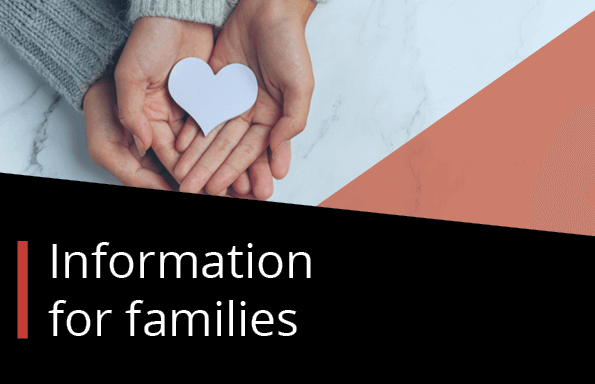Information for Health Professionals
Guiding next-of-kin through the post-mortem process
When a child dies, there are often many questions that parents may ask. One way for parents to better understand what has happened is through a post-mortem examination of their child.
Download a printable version of information for parents after the loss of your child.
Consenting to a post-mortem
Consent to perform a post-mortem is a requirement under law. We suggest that it is most appropriate for the senior clinician treating the patient to approach the family regarding a post-mortem, rather than delegate this duty to a junior medical officer or untrained interviewing officer. Requesting a post-mortem and discussing organ retention and other sensitive information should be conducted face-to-face wherever possible.
The three principles guiding consent are:
- Consent must be informed. The person obtaining consent must supply adequate information about the process.
- Consent must be freely given and free from coercion.
- The person giving consent must understand what is about to occur.
Who can obtain consent?
Consent is to be obtained by a senior clinician treating the patient and the signature of a senior clinician is required before the post-mortem can proceed.
The clinician’s signature must be provided and their name clearly legible.
Documentation and forms
Each case received by the mortuary must be accompanied by all the appropriate and relevant documentation before any form of examination can take place.
PathWest requires informed parental consent for all post-mortem examinations.
Perinatal Post-mortem Frequently Asked Questions
A post-mortem is an examination performed after death to provide as much information as possible to explain the cause of death. The examination is performed by a medical specialist called a Paediatric Pathologist who is experienced and trained specifically in this area.
There are 3 types of post-mortem examination:
The informed wishes of the parents are the basis of what happens to their child after death. The choice of type of post-mortem examination is always determined by the parents/next of kin.
During an external post-mortem examination, only the external part of the body is examined, and no incisions are made. No internal organs are studied. Clinical photographs, measurements and x-rays are taken as part of the procedure.
A full post-mortem examination is the most complex and detailed type of post-mortem and allows the pathologist to examine all the organs to obtain the most information possible. To perform the autopsy, incisions are made along the chest, abdomen (tummy) and scalp. After the post-mortem these incisions will delicately repaired and are usually not visible once the child has been carefully dressed.
Clinical photographs, measurements and x-rays are taken as part of the procedure.
Each of the individual organs is examined, weighed and small samples from each organ are taken for microscopic examination. If necessary, small samples are taken for investigating infectious organisms or genetic testing.
During a limited post-mortem, only a specific organ or groups of organs are examined. For example, the abdominal and chest organs are examined, but the brain is not examined. Alternatively, only the chest organs may be examined. The incision made to the body depends on the organ/s to be examined.
A limited post-mortem also applies when tissue needs to be collected for further genetic investigation (such as muscle or skin). In such a case, a small incision (approximately 1 cm in size) is made through the skin (usually the thigh) and a pea-sized piece of muscle is taken. The skin incision is then sutured closed.
Clinical photographs, measurements and x-rays are taken as part of the procedure.
No. Non-coronial mortuaries do not offer CT scanning or MRI imaging.
Yes, a child who dies outside of the hospital may have a non-coronial autopsy. The treating clinician will need to complete a post-mortem consent form as per usual practice. The post-mortem coordinator can assist with this process. The PCH mortuary staff will arrange the transport of the child to the appropriate PathWest facility for post-mortem. A Paediatric Pathologist will perform the post-mortem. To discuss the post-mortem and request the transfer, please contact the PCH mortuary staff.
Although a post-mortem is a very specialised examination, it is not always possible to determine the cause of death or explain all the findings despite extensive investigations/testing.
A set of clinical photographs are taken for every post-mortem. These photographs may be shared with other treating clinicians.
For a full or limited post-mortem examination, small specimens (about the size of a pea) are routinely taken from every major organ for microscopy to detect disease. This is like a biopsy taken during life. Similar sized samples may be taken for testing by other departments (e.g. genetics, microbiology, and virology). A small piece of tissue is also taken for storage for further testing (such as genetics). The decision of what tissue is taken is determined by the pathologist at the time of the post-mortem. The results of these additional tests are included in the final report.
Unless permission is granted all tissues not used for further testing, or tissue that is stored (such as frozen tissue), are returned to the body at completion of the post-mortem.
The tissue is processed into a paraffin block from which a microscope slide is produced. The pathologist will study the slide under the microscope to determine if there is any disease. The blocks and slides are kept indefinitely as part of your child’s record and can be referred to at a later stage.
There are several reasons tissue is taken for storage. Firstly, the pathologist may not be sure what extra testing to do (such as genetic testing) on the day the post-mortem is performed. This is especially true when the examination is complex, and it is very useful to have frozen tissue available to send for additional testing once the pathologist has a clear understanding of what the underlying disease process might be. Secondly, medical science (and especially the field of genetics) is growing rapidly, and it is very helpful to have tissue available for advanced testing. The tissue that is taken is frozen at -80 degrees in a special process and is kept at a PathWest laboratory for up to 20 years. This tissue may be used for later for testing, especially genetic testing.
No. Unless the parents have consented for an organ to be retained, all organs are returned to the body. However, some organs such as the brain cannot be examined satisfactorily without chemical treatment (fixation), you may be asked by the pathologist or post-mortem coordinator to obtain parental consent for retention. If permission is granted and an organ is retained for fixation, the options for cremation and burial include: 1. Delay cremation or burial until examination is complete (this may take up to two weeks) or;
2. Proceed with cremation or burial and have a separate interment of the retained organ later.
Yes. Genetic testing is available, and consent must be obtained. Parents can give or decline consent by ticking the ” yes” or ” no” box in Part 2a or 2b or 2c of the consent form. Whilst genetic testing is very sophisticated, it may not always provide an answer. Sometimes genetic testing may indicate that other family members could be a carrier of disease and should be tested. Please discuss the implications of genetic testing with the parents.
Yes. The law allows the use of tissue for other purposes such as research, training and education, and quality assurance purposes. Consent to allow tissue to be available for ethical research, or other purposes, can be given with the post-mortem consent process. It is important to note that all research must be consistent with the National Health and Medical Research Council National Statement on ethical conduct in research involving humans and approved by the hospital ethics team. All tissue will be de-identified.
The post-mortem report is an integrated pathology report containing:
The final report usually includes a comment which summarises the salient findings and integrates these into a unified cause of death. The comment may also provide suggestions for further management (such as referral of other family members for genetic testing).
The post-mortem examination may take place at one of three PathWest locations: The Paediatric & Perinatal Pathology Department at Perth Children’s Hospital (PCH), the Mortuary at Fiona Stanley Hospital (FSH) or the Mortuary at Sir Charles Gardiner Hospital (SCGH) QEll.
The choice of location is at the discretion of the pathologist.
If an examination is requested, the child will be transferred to the appropriate PathWest department:
- Perth Children’s Hospital – for babies up to about 6 months
- Fiona Stanley hospital – for children and teenagers
- Sir Charles Gardiner Hospital – for any child with an infectious disease.
The child will be transported between sites by funeral directors. On arrival at the required location, a Paediatric Pathologist will perform an examination in accordance with the consent provided.
The child will remain at the hospital the examination took place.During a post-mortem examination, a training doctor, midwife, nurse, laboratory technician or specialist may be present as part of their training or to review findings.
The full post-mortem report is issued 6 to 8 weeks after the examination.
The post-mortem report is a complex medical document, and it is important that the findings are explained to parents by an experienced medical practitioner, who can answer any questions. It may also be appropriate to plan a further care pathway.
Yes, it is possible for parents to see and hold their child after a post-mortem examination if they would like to. More information is available on the Information for Families page.
Please contact the post-mortem coordinator who can provide more advice and direct you to a paediatric pathologist if required.
The Perth’s Children’s Hospital facilities include a viewing room that can be used by parents and their families to spend time with their child once they have left the ward. Bookings to arrange convenient viewing times are required and can be made by phoning the department on 0456 634 579 (available 9:00am to 4:00pm Monday to Friday).


